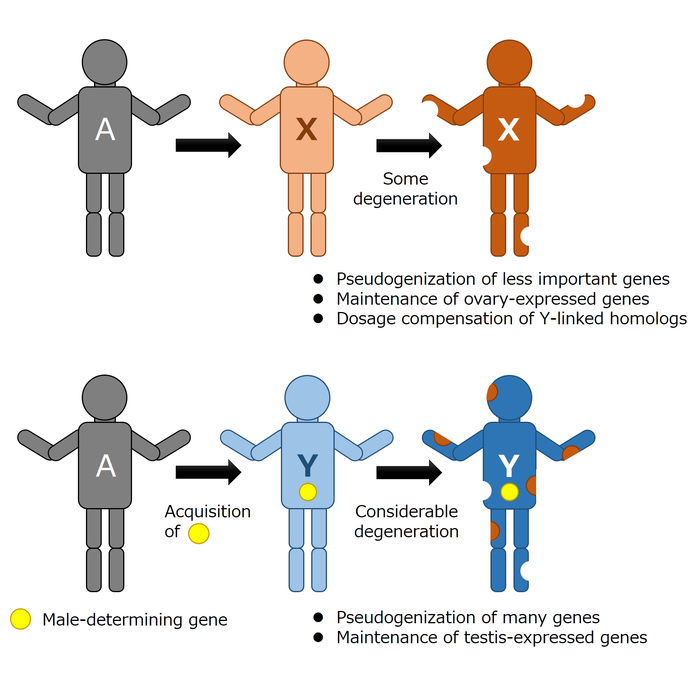Tokyo, Japan – Researchers from Tokyo Metropolitan University have identified unifying features in the early evolution of X and Y chromosomes. Newly evolved sex chromosomes in three different fruit fly species showed the same genetic compensation mechanism found in other organisms. They also found common deterioration in both X and Y, plus key similarities between sex chromosomes derived from the same non-sex chromosome. The team’s insights point to universal traits in sex chromosome evolution in nature.

Credit: Tokyo Metropolitan University
Tokyo, Japan – Researchers from Tokyo Metropolitan University have identified unifying features in the early evolution of X and Y chromosomes. Newly evolved sex chromosomes in three different fruit fly species showed the same genetic compensation mechanism found in other organisms. They also found common deterioration in both X and Y, plus key similarities between sex chromosomes derived from the same non-sex chromosome. The team’s insights point to universal traits in sex chromosome evolution in nature.
Chromosomes are long winding DNA molecules containing all of an organism’s genes. Different chromosomes contain different parts of a complete genetic code, all important in different ways. In the evolution of some animals, including humans, two of these chromosomes, dubbed “X” and “Y”, can pick up certain genes and take on the role of determining how sexual characteristics develop. These are called allosomes or sex chromosomes.
As sex determination sets in along an evolutionary pathway, it becomes unfavorable for sex chromosomes to undergo major changes. Unfortunately, the Y chromosome is prone to a process called pseudogenization, where its genes lose function; compared to the 1000 or so genes in the X chromosome, the Y chromosome in humans has only a few dozen functional genes left. That means that male offspring, with a single X and Y chromosome, have only a single copy of the vast array of vital genes in X, while females, with two X chromosomes, have a backup. So how does the XY pairing manage to get by? In seminal work by Muller in the 30s and Ohno in the 60s, it was found that the X chromosome in males works overtime, in a process known as dosage compensation (DC). But it remains unclear how this kind of process evolved. Given how widely sex determination is seen in nature, any clues promise new insights into the intricate mechanics behind evolution.
In a bid to study DC, a team led by Associate Professor Masafumi Nozawa and Professor Koichiro Tamura of Tokyo Metropolitan University have been studying chromosomes in Drosophila fruit flies. It so happens that in a few species, sex chromosomes were evolved within the last million years. That’s quite recent by evolutionary standards! What this provides is a rare glimpse into the early evolution of sex chromosomes, particularly how pseudogenization is progressing in these “neo-X” and “neo-Y” chromosomes.
By comparing three different species with neo-X and neo-Y and those without, the team found a startling range of common traits. Firstly, they confirmed that neo-Y was already losing genes, and that this was being made up for by an elevation in the activity of those in neo-X. In fact, it turns out that both are being pseudogenized at an accelerated rate compared to their non-sex counterparts, though genes found strongly expressed in the ovaries and testes were still preserved in neo-X and neo-Y respectively. Furthermore, for two species with neo-Y chromosomes derived from the same non-sex chromosome, they found that the same genes were being pseudogenized i.e. evolution was happening in parallel in different species.
The range of similarities found by the team point to universality in how sex chromosomes evolve, offering insights into the evolutionary mechanics of a wider range of organisms.
This work was supported by JSPS KAKENHI Grant Numbers JP25711023, JP15K14585, JP17H05015, JP221S0002, and JP16H06279 from the Japan Society for the Promotion of Science (JSPS) and the Genome Information Upgrading Program of the National BioResource Project (NBRP) .
Journal
Genome Research
DOI
10.1101/gr.275503.121
Article Title
Shared evolutionary trajectories of three independent neo-sex chromosomes in Drosophila
Article Publication Date
21-Oct-2021




